Distribute or digitally share the “Nets” template. Tell students that these images are nets, sets of 2-dimensional (2-D) shapes that, when folded, form the surfaces of 3-dimensional (3-D) shapes. Have students analyze the nets and ask them to think about the number and shapes of each net’s 2-D parts. See if they can predict what 3-D figure each net will fold up into. Then play the instructional math video “Understanding Nets.”
CCSS: 6.G.A.4, *7.G.A.3
TEKS: 7.9D, *G.10A
*Additional standards covered in Skill Builders.
